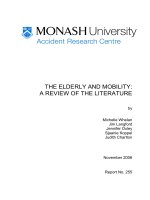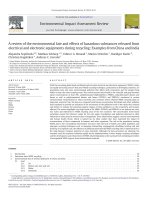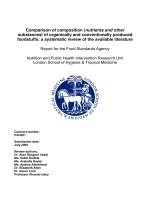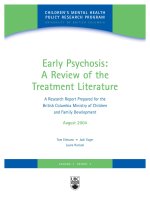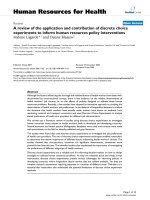early psychosis a review of the treatment literature
Bạn đang xem bản rút gọn của tài liệu. Xem và tải ngay bản đầy đủ của tài liệu tại đây (372.08 KB, 54 trang )
VOLUME 1 REPORT 7
Early Psychosis:
A Review of the
Treatment Literature
A Research Report Prepared for the
British Columbia Ministry of Children
and Family Development
August 2004
Tom Ehmann
■
Jodi Yager
Laura Hanson
CHILDREN’S MENTAL HEALTH
POLICY RESEARCH PROGRAM
UNIVERSITY OF BRITISH COLUMBIA
Children’s Mental Health Policy Research Program
Suite 430 - 5950 University Boulevard
Vancouver BC V6T 1Z3
www.childmentalhealth.ubc.ca
Copyright © The University of British Columbia
CONTENTS
Acknowledgements 2
Preface 3
Executive Summary 4
1. Introduction 6
1.1 Defining Early Psychosis 6
1.2 Rationale and Goals of Early Intervention 7
1.3 Interventions in Early Psychosis 8
2. Methods 9
2.1 Scope 9
2.2 Search Methods 11
3. Pharmacotherapy 13
4. Psychosocial Interventions 22
4.1 Cognitive Behaviour Therapy 22
4.2 Family Intervention 28
4.3 Psychoeducation 32
5. Early Psychosis Programs 33
6. Prevention/Prodromal Intervention 40
7. Discussion 42
8. Recommendations 44
9. References 45
1
ACKNOWLEDGEMENTS
We thank the following people who contributed to the preparation of this report:
■ Charlotte Waddell, Susan Cuthbert, Josephine Hua and Orion Garland
Children’s Mental Health Policy Research Program
■ Provincial Strategy Committee on Early Psychosis
British Columbia Ministry of Children and Family Development
■ Child and Youth Mental Health Team
British Columbia Ministry of Children and Family Development
Funding for this work was provided by:
■ Child and Youth Mental Health Team
British Columbia Ministry of Children and Family Development
2
Early Psychosis: A Review of the Treatment Literature
Children’s Mental Health Policy Research Program, August 2004
1
PREFACE
This is one in a series of research reports being prepared by the Children’s Mental Health Policy Research
Program at the University of British Columbia at the request of British Columbia’s (BC’s) Ministry of Children
and Family Development (MCFD). At any given time, over one in seven or 140,000 children in BC experience
mental disorders serious enough to impair their development and functioning at home, at school and in the
community.
1
MCFD has made it a goal to improve children’s mental health in BC. In 2003, MCFD announced
a new Child and Youth Mental Health Plan (the Plan) to better address the needs of children and families
in BC.
2
The research reports developed through Children’s Mental Health Policy Research Program will support
MCFD’s Plan by identifying the most effective prevention and treatment approaches available for a variety of
children’s mental health problems. This report focuses on early psychosis and is intended to assist MCFD to
provide quality services to young people and their families so that positive outcomes may be maximized for
those affected by the early stages of psychotic disorders. Other reports have focused on conduct disorder, on
First Nations children’s mental health, and on anxiety. Future reports will cover depression, eating disorders,
co-morbidity, attention problems, other mood and developmental problems, suicide prevention, knowledge
exchange, parenting and service models. These reports will be a resource for policy-makers, practitioners,
families, teachers and community members working with children in BC. We recognize that research
evidence is only one component of good policy and practice. This report addresses only the content, or
the specific factors, in treatment modalities for early psychosis. This should not be interpreted as a failure
to recognize the importance of the therapist’s experience, clinical judgment and other non-specific factors
that are beyond the scope of this report. Our goal is to nevertheless facilitate evidence-based policy and
practice by making summaries of the best research evidence available to everyone concerned with
improving the mental health of young people in BC.
3
Early Psychosis: A Review of the Treatment Literature
Children’s Mental Health Policy Research Program, August 2004
1
EXECUTIVE SUMMARY
Psychosis is a serious public health issue that can lead to severe long-term disability. A new paradigm has
emerged in the past decade that aims to decrease the pain and risks associated with psychosis and optimize
the chances of a successful recovery. Despite over 100 years of research, understanding of the causes of
schizophrenia, schizoaffective disorder, bipolar disorder and the other disorders associated with psychosis
remains limited. Although successful treatments have been developed, extrapolation of the research findings
from populations with chronic disorders should not be assumed uncritically. This report reviews research on
the best interventions currently employed for early psychosis, which usually manifests in young people.
Findings
■ Antipsychotic medications are effective for both acute treatment and maintenance. The newer
atypical antipsychotics are more efficacious and enjoy a more favorable side effect profile than
older antipsychotics. Weight gain is a concern with several of the atypical antipsychotics.
■ Family interventions have been shown to improve several outcomes.
■ While the controlled research on cognitive behaviour therapy, psychoeducation and other
psychosocial interventions in early psychosis is limited, research from the general literature
and from less well-controlled studies supports their use.
■ Evidence from specialized early psychosis programs suggests improvements over
standard treatment.
■ Research findings on prevention of psychosis or the ability of interventions to prevent
onset during suspected initial prodromes is at best equivocal.
4
Early Psychosis: A Review of the Treatment Literature
Children’s Mental Health Policy Research Program, August 2004
Recommendations
■ Atypical antipsychotic medications are effective for acute psychoses. Antipsychotic doses should be low
and titrated slowly. The use of multiple antipsychotic medications is not usually warranted. Clozapine
should be reserved for treatment refractory cases.
■ Lithium remains the first line mood stabilizer when mania accompanies psychotic symptoms.
■ Family involvement/interventions are recommended.
■ Cognitive behaviour therapy is advised on the basis of limited support in the first episode literature and
considerable support from the general schizophrenia and affective disorder literature.
■ Psychoeducation receives substantial support in the general literature yet has been infrequently studied in
early psychosis despite being an integral component of most programs. Psychoeducation is recommended
for all cases.
■ Interventions currently used in treating first episode cases are not recommended for use in suspected
onset-prodrome cases. Further research on improving the identification rate must be coupled with rigorous
treatment trials.
■ Current early psychosis guidelines are consistent with the ethics and theoretical framework of the early
intervention paradigm and represent an array of interventions that are often embodied in specialized
programs. No evidence to date suggests these programs represent an inferior option compared to more
traditional treatment approaches. Despite a lack of statistical power, several studies demonstrated clear
advantages to integrated programs over standard care. The individual components of these programs that
contribute to good outcomes needs further study.
■ More research is needed on specific interventions, on mixed interventions embodied in programs, and on
prevention approaches. In particular, studies of the effectiveness of psychoeducation and group versus
individual therapies are of high priority and must be done using sufficiently sized samples. Outcomes
measured should be multidimensional and include quality of life, cost effectiveness and psychosocial
functioning. Comparisons both between the atypicals and relative to mood stabilizers and first generation
antipsychotics are needed in both affective and nonaffective psychoses. Studies must move beyond
short-term evaluation (e.g., less than one year) to ascertain whether early intervention significantly
alters the course of disorders over many years.
5
Early Psychosis: A Review of the Treatment Literature
Children’s Mental Health Policy Research Program, August 2004
1
INTRODUCTION
1.1 Defining Early Psychosis
Psychotic conditions are a major public health concern. Persons with psychosis may engage in actions
that are dangerous to themselves and others. Onset in late adolescence and early adulthood causes major
disruptions in the ability of individuals to meet developmental tasks. Social, sexual, academic and vocational
challenges may be threatened as are consolidation of personal independence, identity and values. Individuals
experiencing psychoses are more prone to suicide, depression, anxiety, aggression, substance abuse, cognitive
impairment, victimization, poverty and increased medical problems.
3,4
When psychosis occurs, family and
other social relationships suffer, and the family experiences significant distress.
5
The most common diagnoses associated with psychosis are schizophrenia, schizophreniform disorder,
schizoaffective disorder, bipolar disorder, and major depression with psychotic features. Most psychotic
disorders tend to follow a relapsing course wherein periods of acute psychosis are preceded by periods of
disruption (a “prodrome”) and followed by recovery, deterioration, and subsequent re-emergence of florid
psychosis. Conceptualizing the disorder as consisting of these phases suggests that different strategies
become appropriate for assessment and treatment at each stage.
6
Outcomes for psychotic disorders are generally disheartening. A recent epidemiological outcome study
reported that three quarters of first episode patients with schizophrenia and almost half of those with
non-affective psychoses were receiving work disability benefits after five years.
7
Nine per cent of the
schizophrenia patients and 39 per cent of the non-schizophrenia patients were rated as not being in need
of treatment. Schizophrenia is associated with poorer functional outcomes and slower recoveries from
episodes than other psychotic disorders.
8,9
Bipolar disorder is a prototypical relapsing-remitting psychiatric
disorder. Lifetime prevalence is about 1.6 per cent.
10
Patients who have ever been hospitalized are expected
to spend about 20 per cent of their lifetime in episodes (starting from the onset of their disorder).
11
Two
years after an initial episode of mania, 72 per cent achieved syndromal recovery but only 43 per cent
attained functional recovery.
12
Finally, major depression accompanied by psychosis leads to poorer five- and
10-year symptomatic and functional outcomes compared to non-psychotic depressions.
13
For all psychotic
disorders, the better the short-term course, the better the long-term outcome with the percentage of time
spent with psychotic symptoms in the first few years being the best predictor.
8
6
Early Psychosis: A Review of the Treatment Literature
Children’s Mental Health Policy Research Program, August 2004
1.2 Rationale and Goals of Early Intervention
Many studies have found long delays before treatment began in first-episode psychoses, including bipolar
disorder.
14
Long durations of untreated psychosis have been associated with slower and less complete
recovery, more biological abnormalities, more relapses and poorer long-term outcomes.
15-17
Assessment
and treatment procedures were often experienced by clients as traumatizing, alienating, age-inappropriate
and inconsistently applied over time.
18
The early phase of psychosis, the period when most deterioration occurs, may represent a “critical period”
for determining long-term outcome.
19
This period may present an important treatment opportunity because
course-influencing biopsychosocial variables, including patient and family reactions, develop and show
maximum ability to positively change during this time.
20
Early intervention in psychosis aims to achieve:
• better short- and long-term prognoses
• increased speed of recovery
• lower use of hospitalization
• reduced secondary psychiatric problems (e.g., depression, substance abuse, etc.)
• preservation of personal assets, psychosocial skills, role functions, family functioning and
social/environmental supports
Achieving these goals entails:
• providing age-appropriate support to minimize disruption in the lives of these individuals and
enable them to more successfully meet their developmental challenges
• limiting the suffering and possible negative repercussions of psychotic behaviour through
improving early recognition and rapid appropriate response
• involving and assisting families
• adopting a wide range of treatment targets
• remaining sensitive to factors that may hinder successful ongoing treatment, such as
– negative effects generated by aversive procedures
– medication side effects
– discontinuities in care
– stigma and other impediments to collaborative relationships
7
Early Psychosis: A Review of the Treatment Literature
Children’s Mental Health Policy Research Program, August 2004
1.3 Interventions in Early Psychosis
The goals of early intervention in first episode psychoses necessitate the implementation of a broad
biopsychosocial approach. The development of innovative approaches is demanded by the diagnostic
uncertainty inherent in many early phase disorders, and by the goals of providing intensive and continuous
care, family involvement, age- and stage-appropriate services, and liaison with school, work and community
services. Furthermore, careful attention to co-morbid psychiatric and social problems, rapid reintegration
and relapse prevention are formidable challenges. Most existing mental health services have not been
developed to provide the type of care envisioned in the early intervention paradigm. Evaluation of these
services is in its infancy. Many of the treatments for psychotic disorders are conducted and researched
using populations with chronic illness and are reflected in the practice guidelines published for most
disorders.
21,22
Although efficacy has been established in many realms, the assumption that these
treatments will always be appropriate and effective in early psychosis cases is equivocal. The only
widely published guidelines expressly directed at early psychosis are predominantly clinically derived.
23
Early psychosis intervention also must account for significant variation in disorders, cultural differences
and service delivery systems while retaining consistency in the operationalization of theoretical and ethical
underpinnings. This review will not address all of the clinical concerns that arise because of this diversity.
Nor will it address service delivery issues such as models, structures, professional staffing and health
economics. Rather, attention is focused on research pertaining to those interventions that are widely
employed.
8
Early Psychosis: A Review of the Treatment Literature
Children’s Mental Health Policy Research Program, August 2004
2
METHODS
2.1 Scope
For the purpose of this report, early psychosis was defined as a five-year period following a first episode of
either non-affective or affective psychosis that occurs in individuals during adolescence or early adulthood.
The review focused on studies investigating the effects of early psychosis programs, treatments, and
prevention efforts on clinical outcomes considered to be core features of early psychosis.
Issues not considered central to this review include:
• populations with longstanding or chronic psychotic disorders
• populations with very early or late onset psychosis
• service delivery matters in isolation from specific interventions (e.g., case management models
and organizational issues)
• interventions focused solely on treatment of secondary effects of either psychosis or treatments
for psychosis (e.g., interventions for substance abuse in psychosis or interventions for medication
side effects)
2.2 Search Methods
Searches were performed using several databases including Medline, PubMed, PsychINFO and
the Cochrane Collaboration Database.
9
Early Psychosis: A Review of the Treatment Literature
Children’s Mental Health Policy Research Program, August 2004
Where possible, search terms were matched with subject headings and searched as keywords. Search terms
were modified according to the database searched.
Searches were done broadly without limits other than “English Language” and “Human Subjects.” All
abstracts obtained through these searches were assessed for interventions or prevention studies with
clinically relevant outcome measures (either original study or review) within early psychosis. In order to
ensure that all studies with the highest level of evidence were included, searches were rerun with the limit
“Randomized Controlled Trial” and crosschecked. Review papers and book chapters were hand searched to
identify any additional studies. Finally, the manufacturers of the three atypical antipsychotic medications
used in early psychosis in BC were contacted and kindly provided references regarding their respective
medications.
10
Early Psychosis: A Review of the Treatment Literature
Children’s Mental Health Policy Research Program, August 2004
Early Psychosis
• early
• first-episode
• recent-onset
• adolescent
• adolescence
in conjunction with
diagnostic terms:
• psychosis
• psychotic disorder
• schizophrenia
• schizoaffective
• schizophreniform
• depression
• bipolar disorder
• mania
• manic
Treatment-
Pharmacotherapy
• antipsychotic
agents
• antimanic agents
• drug therapy or
treatment or
intervention
combined with early
psychosis terms
Treatment-
Psychosocial
Interventions
• psychosocial
• cognitive
• behaviour
• group
• family
combined with:
• therapy
• treatment
• intervention
or
• psychotherapy
• patient education
• psychoeducation
combined with early
psychosis terms
Programs
•evaluation
studies
combined with
early psychosis
terms
or
all known early
psychosis
program names
(e.g., EPPIC,
TIPS, PEPP)
Prevention/
Prodromal
Intervention
• at-risk mental
state
• prodrome
• prodromal
or
• high risk
• at risk
in conjunction with
diagnostic terms
combined with:
• prevention
• intervention and
pharmacotherapy,
psychosocial
treatments and
program terms
TABLE 1. Search Terms
Articles retrieved were reviewed for inclusion according to the following criteria:
24
Studies were reviewed starting with those that had the highest level of evidence available (i.e., studies that
had random allocation of participants to comparison groups). For topics where this level of evidence was not
available, non-randomized studies with a comparison group were reviewed. Controlled trials were outlined
in tables and discussed first. Where there was insufficient data from controlled trials, evidence from
uncontrolled trials in early psychosis was discussed. Where this data was lacking, discussion turned to
the general literature on long-standing psychotic disorders. Disagreements about which articles to include
were resolved by consensus involving all the authors.
11
Early Psychosis: A Review of the Treatment Literature
Children’s Mental Health Policy Research Program, August 2004
TABLE 2. Inclusion Criteria
Basic Criteria
• Original or review articles in English about humans
• About topics relevant to children’s mental health in BC communities
Reviews
• Clear statement of relevant topic
• Clear description of the methods including sources for identifying literature reviewed
• Explicit statement of criteria used for selecting articles for detailed review
• At least two studies reviewed met criteria for assessing original research studies
Research Studies
• Clear descriptions of participant characteristics, study settings and interventions
• Diagnostic “gold” standard for early psychosis or at-risk mental state
• 50% or more of participants were in their first or second episode or within the first five years of illness
• Random allocation of participants to comparison groups
• Double-blinding procedures for medication studies
• The criterion of 80% completion rate for interventions was relaxed because it would have excluded most
pharmacotherapy trials and studies that depended on long follow-up periods. Completion rates reported in
individual studies are cited in the tables.
• Outcome measures of both clinical and statistical significance (response criteria in pharmacotherapy trials was
typically defined as a 40% or 50% drop in score on standardized symptom rating scales and/or ratings of
much or very much improved overall)
12
Early Psychosis: A Review of the Treatment Literature
Children’s Mental Health Policy Research Program, August 2004
Pharmacotherapy
Psychosocial
Interventions
Programs
Prevention
Number of Articles Retrieved
and Assessed
50
47
19
5
Number of Studies
Represented in Tables
13
12
6*
2
TABLE 3. Studies Included
* Refers to programs (not studies) represented.
3
PHARMACOTHERAPY
Randomized Controlled Trials
Pharmacotherapy is the most researched intervention in early psychosis. Table 1 summarizes the
13 randomized controlled trials addressing first episode psychosis done to date. Most samples consisted of
patients with schizophrenia spectrum disorders with only two studies using exclusively bipolar patients.
Most studies were short term (e.g., 5-12 weeks) and examined symptomatic reduction efficacy and safety.
The available evidence suggests that the atypical antipsychotics are at least as efficacious as typicals in
decreasing psychopathology. In all studies the percentage of patients who met response criteria was higher
with the atypicals. The atypicals also showed several advantages regarding side effects with the exception of
greater weight gain. Dropout rates were lower for atypical antipsychotics, which suggests better tolerability
of these medications. Several studies found that low doses were preferable to high doses. Two trials that
studied relapse rates (Crow;
25
Kane
26
) showed efficacy of typicals versus placebo in preventing relapse. The
one-year clozapine study showed equal efficacy to chlorpromazine but greater speed of recovery with
clozapine. Quicker response time was also found for risperidone and olanzapine versus haloperidol (Sikich
27
).
The evidence for the use of mood stabilizers is limited with one trial (Geller
28
) showing lithium reducing
substance abuse (but not mood symptoms) in bipolar disorder patients more than placebo. A second showed
that quetiapine appeared to boost the effectiveness of divalproex in treating manic symptoms.
One further double-blind study was not included in the table because it focused on very treatment refractory
patients with early onset schizophrenia.
29
This study found that clozapine showed several advantages over
haloperidol in treating symptoms of psychosis.
Other Evidence
The volume of research specific to first episode psychosis considerably lags the number of studies published
on long standing affective and non-affective disorders. The assumption that studies using established illness
may be extended to earlier phases of illness and younger patient populations has been adopted frequently in
clinical practice. However, this practice may not be wholly defensible on empirical grounds. The efficacy of
the atypical antipsychotics for the treatment of acute episodes of schizophrenia and mania has considerable
support from randomized controlled trials, systematic reviews and meta-analyses.
30-32
The clinical efficacy of
olanzapine, risperidone, clozapine, amisulpride and quetiapine are well documented compared to typical
antipsychotic medications. The efficacy of antipsychotics in schizoaffective disorder has also been
confirmed.
33
The available evidence suggests that treatment of schizoaffective disorder with both a mood
stabilizer and antipsychotic may be optimal although further research on maintenance therapy is especially
needed.
34
Despite this body of research, direct transfer of findings to first episode patients is not always appropriate.
For example, the doses used in efficacy studies was often much higher than those found to be optimal in first
13
Early Psychosis: A Review of the Treatment Literature
Children’s Mental Health Policy Research Program, August 2004
episode cases
35-37
and younger populations appear to be more susceptible to side effects.
27
Clozapine, the gold
standard medication for treatment resistant schizophrenia, has not been shown to confer benefit over other
antipsychotics in treating first episode schizophrenia or schizoaffective disorder.
38
The studies in the pharmacotherapy table also show that typical antipsychotic medication helps prevent
relapse in early phase schizophrenia. Studies regarding the atypicals and relapse are limited to established
illness. Systematic reviews and meta analyses have concluded that, compared to typicals, relapse rates were
modestly but significantly lower with the atypicals.
39
Medication nonadherence is a common problem in affective and non-affective psychoses. In first episode
cases followed for one year, about 40 per cent were adherent, 20 per cent inadequately adherent and
40 per cent nonadherent with younger age, poorer premorbid functioning, substance use and younger
age at onset being significant predictors on nonadherence.
40
Relapse when medication is withdrawn after
remission of the initial episode of schizophrenia is common.
41
In light of the fact that many patients are
nonadherent and that about 20 per cent of patients with schizophrenia will not have another episode,
42
an approach called intermittent targeting is being evaluated.
43
In this approach, medication is withdrawn
under close monitoring conditions and is restarted at the earliest signs of deterioration. One study of
medication withdrawal in remitted first episode schizophrenia patients found that when symptomatic
exacerbation was used as a criterion, 96 per cent relapsed within two years.
44
However, when rehospitalization
was used as a criterion, the relapse rate fell to 13 per cent. These results and others
43
suggest that intermittent
targeting can be a useful approach for patients who no longer take antipsychotic medication.
Finally, numerous controlled studies have now been conducted that show the atypicals exert positive effects
on the cognitive dysfunctions found in schizophrenia spectrum disorders.
45
This may prove to be especially
important since neurocognitive deficits have been associated with poorer functional outcomes.
46,47
Side Effects of Antipsychotic Medications
■ Motor – The rates and severity of extrapyramidal side effects are considerably lower with
atypical medications as shown in the table and via other studies in established illness samples.
32,48-50
■ Cardiac – Although the potential for cardiac abnormalities (torsade de pointes) resulting in
sudden death has been confirmed for the typical antipsychotics, no association has been found
with olanzapine, risperidone and quetiapine.
51
■ Weight gain – Weight gain is associated with the atypicals but a large variation exists with
clozapine and olanzapine producing the most and ziprasidone producing the least.
52
■ Diabetes – A study of 38,632 patients in the United States found that, after controlling for age, patients
who received an atypical antipsychotic had a nine per cent greater chance of developing diabetes
compared to those who receive a typical antipsychotic.
53
14
Early Psychosis: A Review of the Treatment Literature
Children’s Mental Health Policy Research Program, August 2004
Pharmacotherapy of Affective Psychoses
Table 1 showed that little research has been published regarding the most efficacious treatments for
affective disorders that present with psychotic features. Lithium is an established treatment and quetiapine
was shown to assist in the reduction of manic symptoms when added to lithium. Traditionally, lithium and
divalproate have been considered first line treatment for acute and maintenance treatment.
22,54
More recently,
randomized controlled trials using populations with established illness have demonstrated the efficacy of
atypical antipsychotics in acute mania as both monotherapy and adjunctive to “mood stabilizers.
55,56
Maintenance therapy for bipolar disorder with antipsychotic medication has begun to receive some support
from controlled trials
55
both as monotherapy and as adjunctive therapy.
57
The optimal time period for which
antipsychotic medication should be continued in remitted bipolar patients presenting with psychosis remains
to be determined.
58
15
Early Psychosis: A Review of the Treatment Literature
Children’s Mental Health Policy Research Program, August 2004
Study
Crow,
MacMillan,
Johnson
et al.
25
(UK)
DeHaan,
van Bruggen,
Lavalaye
et al.
65
(Holland)
Sample
•n = 120
•
Age:
15-70 years
(74% under 30)
•
Sex:
62% male
•
Ethnic Majority:
Caucasian (69%)
•
Diagnosis:
nonaffective
psychoses
•
Other Information:
First episode
•n = 24
•
Age:
17-28 years
•
Sex:
96% male
•
Ethnic Majority:
Not reported
•
Diagnosis:
Schizophrenia (100%)
•
Other Information:
First (83%) or
second episode
Intervention
•Typical antipsychotics
(n = 54) – variable
dose range
• Provided for 2 years
• Olanzapine
(n = 12) – fixed
dose = 7.5 mg/day
• Provided for 6 weeks
Findings
• 89% of sample completed
intervention
• 1-year follow-up:
Lower relapse rates in
antipsychotic vs. placebo
group (38% vs. 63%)
• 2-year follow-up:
Lower relapse rates in
antipsychotic vs. placebo
group (58% vs. 70%)
• Overall, longer DUPs
associated with higher risk
of relapse
• 75% of olanzapine and
92% of haldol group
completed intervention
• No group differences in
psychopathology, subjective
well-being, or side effects
• Overall, significant
improvement on global
measure of illness severity
(no group differences)
•D2 receptor binding
(between 60-70%) was
associated with better
subjective experiences
Design
•
Comparison Group(s):
Placebo (n = 66)
•
Drop-out Analyses:
Listwise
•
Comparison Group(s):
Haldol (n = 12) – fixed
dose = 2.5 mg/day
•
Drop-out Analyses:
Pre post listwise
TABLE 4. Pharmacotherapy for Early Psychosis
16
Early Psychosis: A Review of the Treatment Literature
Children’s Mental Health Policy Research Program, August 2004
Study
Delbello,
Schwiers,
Rosenberg
et al.
64
(US)
Emsley
37
(International)
Sample
•n = 30
•
Age:
12-18 years
•
Sex:
53% male
•
Ethnic Majority:
Caucasian (83%)
•
Diagnosis:
Bipolar disorder
(47% with psychosis)
•n = 183
•
Age:
15-50 years
•
Sex:
71% male
•
Ethnic Majority:
Caucasian (62%)
•
Diagnosis:
Schizophrenifor
m disorder (93%)
•
Other Information:
First episode
Intervention
• DVP + quetiapine
(n = 15) – mean
quetiapine dose = 432 mg/day
• Provided for 6 weeks
• Risperidone – dose range
= 2-16 mg/day;
mean = 6.1 mg/day
• Provided for 6 weeks
Findings
• 53% of quetiapine and 93%
of placebo group completed
intervention
• Significantly greater clinical
response in DVP +
quetiapine group (87%)
vs. DVP + placebo group
(53%)
• No group differences in
positive symptoms,
depression, overall
functioning, or as-needed
lorazepam use
• Significantly greater
sedation in the quetiapine
DVP + group
• 80% of risperidone and
69% of haloperidol group
completed intervention
• 63% of risperidone and
56% of haloperidol group
met response criteria:
- at < 6mg/day, 74% of
risperidone and 62% of
haloperidol group met
response criteria
- at > 6 mg/day, 59% of
risperidone and 55% of
haloperidol group met
response criteria
• Overall, significant decrease
in symptoms (no group
differences)
•Haloperidol group
experienced significantly
more extrapyramidal side
effects and received
significantly more
anticholinergics
•Post-hoc analyses revealed
dose-related side effects
in both groups (better
responses for low
doses)
Design
• Stratified by psychosis
and sex
•
Comparison Group(s):
Placebo + divalproex
(DVP; n = 15)
•
Drop-out Analyses:
Intent to treat -
(Repeated
ANCOVAs)
•
Comparison Group(s):
Haloperidol – dose
range = 2-16 mg/day;
mean = 5.6 mg/day
•
Drop-out Analyses:
Intent to treat
TABLE 4. Pharmacotherapy for Early Psychosis, continued
17
Early Psychosis: A Review of the Treatment Literature
Children’s Mental Health Policy Research Program, August 2004
Study
Geller, Cooper,
Sun et al.
28
(US)
Kane, Rifkin,
Quitkin et al.
26
(US)
Lane, Chang,
Chiu et al.
63
(Taiwan)
Sample
•n = 24
•
Age:
12-18 years
•
Sex:
64% male
•
Ethnic Majority:
Caucasian (100%)
•
Diagnosis:
Bipolar disorder
with substance
dependence
•n = 28
•
Age:
mean = 22 years
•
Sex:
50% male
•
Ethnic Majority:
Not reported
•
Diagnosis:
Schizophrenia (100%)
•
Other Information:
First episode
•n = 24
•
Age:
18-45 years
•
Sex:
65% male
•
Ethnic Majority:
Chinese (100%)
•
Diagnosis:
Schizophrenia (100%)
•
Other Information:
All drug-naïve,
first episode
Intervention
• Lithium
(n = 13) – 0.9 – 1.3 mEq/L
serum levels
• Provided for 6 weeks
• Fluphenazine
(n = 11) – dose range
= 5-20 mg/day oral
or 12.5-50 IM every
two weeks
• Provided for 1 year
• Low dose risperidone
(n = 12) – 3 mg/day
• Provided for 6 weeks
Findings
•77% of lithium and 92% of
placebo group completed
intervention
• 46% of lithium and 8% of
placebo group met response
criteria
• Significantly fewer positive
urine drug screens in lithium
group (i.e., decreased drug
use)
•No significant group
differences in mood
•More polydipsia and
polyuria in lithium group
• 45% of fluphenazine and
59% of placebo group
completed intervention
•0% of fluphenzine and 41%
of placebo group relapsed
• 42-month follow-up:
- 93% of original sample
assessed
- medication compliance
unknown
• Overall, 69% experienced
a second episode either
during drug trial or during
follow-up, and of those,
77% experienced a
third episode
• 83% of sample completed
intervention
• 64% of low dose and 67%
of high dose group met
response criteria
• Lower side effect ratings
and fewer anticholinergic
meds required in low dose
group
• No group differences in
time to response (median
= 28 days)
Design
•
Comparison Group(s):
Placebo (n = 12)
•
Drop-out Analyses:
Intent to treat
-completers
•
Comparison Group(s):
Placebo (n = 17)
•
Drop-out Analyses:
Not reported
•
Comparison Group(s):
High dose risperidone
(n = 12) – 6 mg/day
•
Drop-out Analyses:
Intent to treat
(LOCF)
TABLE 4. Pharmacotherapy for Early Psychosis, continued
18
Early Psychosis: A Review of the Treatment Literature
Children’s Mental Health Policy Research Program, August 2004
Study
Lieberman,
Phillips, Stroup
et al.
60
(China)
Sample
•n = 164
•
Age:
15-42 years
•
Sex:
52% male
•
Ethnic Majority:
Chinese (100%)
•
Diagnosis:
Schizophrenia (100%)
•
Other Information:
All treatment naïve,
first episode
Intervention
• Clozapine
(n = 81) – median dose
= 300 mg/day
• Provided for 52 weeks
Findings
• 85% of clozapine group and
• 78% of CPZ group completed
intervention
• 81% of clozapine and 79%
of CPZ groups met response
criteria
• Significantly faster time to
remission in clozapine group
• No group differences in
psychiatric symptoms,
rehospitalization rates,
extrapyramidal side effects,
or glucose metabolism
• CPZ group demonstrated
more blurred vision,
sweating, dry mouth,
akathisia, higher heart
rate and longer QT intervals
• All CPZ patients were on
prophylactic anticholinergic
medication
• In both groups, longer DUP
associated with lower
chance of achieving
remission
• 135-week follow-up:
Trend towards greater %
weight gain for clozapine vs.
CPZ group (9.9 kg vs. 6.5 kg)
Design
•
Comparison Group(s):
Chlorpromazine
(CPZ; n = 83) – median
dose = 400 mg/day
•
Drop-out Analyses:
Intent to treat
(LOCF)
TABLE 4. Pharmacotherapy for Early Psychosis, continued
19
Early Psychosis: A Review of the Treatment Literature
Children’s Mental Health Policy Research Program, August 2004
Study
Lieberman,
Tollefson,
Tohen et al.
61
(US & Europe)
Merlo, Hofer,
Gekle et al.
36
(Switzerland)
Sample
•n = 263
•
Age:
16-40 years
•
Sex:
82% male
•
Ethnic Majority:
Caucasian (53%) and
Black (38%)
•
Diagnosis:
Non-affective psychoses
•
Other Information:
First episode
•n = 52
•
Age:
16-40 years
•
Sex:
55% male
•
Ethnic Majority:
Not reported
•
Diagnosis:
Non-affective psychoses
•
Other Information:
First episode
Intervention
• Olanzapine –
mean dose = 9.1 mg/day
• Provided for 12 weeks
during acute phase
• Low dose risperidone
(2 mg/day)
• Provided for 8 weeks
Findings
• 68% of olanzapine and
54% of haloperidol group
completed intervention
• 55% of olanzapine and
46% of haloperidol group
met response criteria
• Using LOCF analyses, there
was a significant decrease
in positive/negative symptoms
and depression in both
groups, but no group
differences
• Using regression analyses,
there was a significantly
greater decrease in positive/
negative symptoms and
depression in the
olanzapine group
•Haloperidol group
showed significantly more
extrapyramidal side effects
and received significantly
more anticholinergics,
propranolol, and
benzodiazepines
• 62% of olanzapine group
gained more than 7% of
body weight (vs. 23% of
haloperidol group)
• 87% of low dose and 73%
of high dose group
completed intervention
• Overall, significant decrease
in psychiatric symptoms
• No group differences in
symptoms or functioning
• Symptomatic remission
criteria met at 8 weeks for
70% low dose and 77% for
higher dose
•2 low dose and 3 higher
dose patients received
biperiden for dystonia
• No patient withdrawals
due to side effects
•Motor functioning
significantly better in
low dose group
Design
•Parallel groups design
•
Comparison Group(s):
Haloperidol –
mean dose
= 4.4 mg/day
•
Drop-out Analyses:
Intent to treat
(LOCF and random
regression coefficients
analyses)
• Parallel groups
design – matched on
neuropsychology
motor tests
•
Comparison Group(s):
High dose risperidone
(4mg/day)
•
Drop-out Analyses:
Intent to treat
TABLE 4. Pharmacotherapy for Early Psychosis, continued
20
Early Psychosis: A Review of the Treatment Literature
Children’s Mental Health Policy Research Program, August 2004
Study
Sanger,
Lieberman,
Tohen et al.
59
(International)
Scottish
research
group
62
(UK)
Sample
•n = 83
•
Age:
mean
= 28.4 years
•
Sex:
71% male
•
Ethnic Majority:
Caucasian (84%)
•
Diagnosis:
Non-affective psychoses
•
Other Information:
Early psychosis
(within 5 years of first
episode)
•n = 46
•
Age:
16-68 years
(mean = 30)
•
Sex:
46% male
•
Ethnic Majority:
Not reported
•
Diagnosis:
Schizophrenia (100%)
•
Other Information:
First episode
Intervention
• Olanzapine
(n = 59) – mean dose
= 11.6 mg/day
• Provided for 6 weeks
• Flupenthixol
(n = 23; mean dose = 20 mg)
vs. pimozide (n 23; mean
dose = 18.8 mg)
• Provided for up to 5 weeks
Findings
• 73% of olanzapine and
38% of haloperidol group
completed intervention
• Significantly higher clinical
response in olanzapine
group (67% vs. 29% in
haloperidol group)
• Significantly greater
decrease in positive and
negative symptoms in the
olanzapine group
•Haloperidol group
experienced significantly
more extrapyramidal side
effects and received
significantly more
anticholinergic medications
• Greater % weight gain for
olanzapine (4.1 kg) vs.
haloperidol group (0.5 kg)
• 78% of pimozide and 87%
of flupenthixol group
completed intervention
• 63% of sample met
response criteria (no group
differences)
• Both drugs led to significant
improvements in functioning
and symptoms (no group
differences)
•No significant group
difference in parkinsonism
Design
•
Comparison Group(s):
Haloperidol
(n = 24) – mean dose
= 10.8 mg/day
•
Drop-out Analyses:
Intent to treat
•
Drop-out Analyses:
Listwise
TABLE 4. Pharmacotherapy for Early Psychosis, continued
21
Early Psychosis: A Review of the Treatment Literature
Children’s Mental Health Policy Research Program, August 2004
Study
Sikich, Hamer,
Bashford
et al.
27
(US)
Sample
•n = 50
•
Age:
8-19 years
(mean = 15)
•
Sex:
60% male
•
Ethnic Majority:
Caucasian (60%)
•
Diagnosis:
Mixed affective
and nonaffective
psychoses
•
Other Information:
78% first episode
Intervention
• Olanzapine or risperidone:
1) Olanzapine – mean
dose = 12.3 mg/day
2) Risperidone – mean
dose = 4.0 mg/day
• Provided for 8 weeks
Findings
• 87% of olanzapine, 53% of
risperidone and 53% of
haloperidol group completed
intervention
• 88% of olanzapine, 74% of
risperidone and 53% of
haloperidol group met
response criteria
•Haloperidol group
demonstrated the slowest
rate of response
• Significant reductions in
symptoms for all groups (no
group differences)
• Differential average weight
gain across groups (7.1 kg
for olanzapine; 4.9 kg for
risperidone; and 3.5 kg for
haloperidol)
•Motor side effects common
to all drugs; anticholinergics
used to treat EPS in > 50%
of each group
• Similar prolactin-related
effects across groups
Design
•
Comparison Group(s):
Haloperidol – mean
dose = 5 mg/day
•
Drop-out Analyses:
Intent to treat
(LOCF)
TABLE 4. Pharmacotherapy for Early Psychosis, continued
4
PSYCHOSOCIAL INTERVENTIONS
The provision of psychosocial interventions is considered vital to early intervention. The review contains
separate tables for CBT and family interventions and a discussion of psychoeducation. Combination therapies
are discussed in the review of early psychosis programs. Each study needed to include a control group to be
included in a table. Randomized controlled trials were found for CBT and family intervention. Randomization
is often very difficult to achieve especially when program effectiveness is being examined.
4.1 Cognitive Behaviour Therapy
Controlled Trials
Three randomized controlled trials with blinding that examined CBT versus standard care were conducted
in the UK (see Table 2). Of the three, only the SoCRATES
66,67
trial had a substantial number of subjects. Both
the SoCRATES and Haddock
68
studies found few differences favoring CBT over manualized supportive
counselling. One study (Drury
69-71
) that used informal support and recreation therapy as a control found better
reduction of positive symptoms and quicker remission for CBT. However, only 70 per cent of subjects were
within the first five years of psychosis and data was not analyzed separately for those with more chronic
psychoses. Follow-up results indicated CBT was associated with greater perceived self-control over the illness,
and both CBT and a formal Supportive Counselling therapy produced lower symptom scores than routine care
or informal support.
Two randomized controlled studies addressed suicidality. One study (OPUS
72
) employed an integrated
treatment model (see Table 4 on early psychosis programs for details ) while the other tested a CBT-based
treatment (LifeSPAN
73
). Both trials found that individuals receiving interventions for suicide prevention
showed decreased hopelessness (a factor associated with suicide risk). Although the experimental groups did
not differ significantly from the controls on measures of suicide attempts, this may reflect the short follow-up
periods. The CBT treatment also produced superior quality of life ratings that were maintained at follow-up.
Another CBT study that lacked random assignment found better depression and quality of life scores
compared to controls (COPE
74,75
). These differences disappeared at follow-up but the high dropout rates from
the control groups obfuscate interpretation. A small study of combined individual and group interventions
(Hodel
76
) aimed at increasing coping and decreasing arousal did not produce differences on social or
emotional functioning compared to standard care but a trend to better social integration was found at
an eight month follow-up.
Conclusions about efficacy of CBT for early psychosis are limited due to the differences in assessed outcomes
across studies and the small number of subjects in most studies. However, the overall results for CBT are not
without promise, as there appear to be some significant and longer lasting benefits. Further research into CBT
for early psychosis is clearly warranted given these findings and in consideration of the more established
efficacy of CBT for treatment-resistant schizophrenia (for review see
77
).
22
Early Psychosis: A Review of the Treatment Literature
Children’s Mental Health Policy Research Program, August 2004
At this stage, its clinical use within early psychosis should be limited to individuals demonstrating prolonged
recovery or secondary morbidities such as depression as there is a more established CBT literature to provide
guidance for these problem areas.
23
Early Psychosis: A Review of the Treatment Literature
Children’s Mental Health Policy Research Program, August 2004
Study
COPE
Jackson,
McGorry,
Edwards
et al.
74
Jackson,
McGorry,
Henry et al.
75
(Australia)
Sample
•n = 80
•
Age:
16-30 years
(mean = 30.7 years)
•
Sex:
64% male
•
Ethnic Majority:
Not reported
•
Diagnosis:
Mixed affective and
nonaffective psychoses
•
Other Information:
First episode
Intervention
•Manual-based individual CBT
(n = 44) focused on:
1) assessment
(e.g., explanatory model)
2) engagement
3) coping skills, behavioural
activities, and dealing
with cognitive ‘roadblocks’
4) secondary morbidity
treatment
• 40-minute sessions provided
once every week or 2 weeks
(mean total sessions =
18; range = 2-40)
Findings
• 100% of sample
completed post-treatment
assessment
• In comparison to control
group, COPE participants
demonstrated superior
understanding of illness
(i.e., explanatory models),
less depression and
superior quality of life
• In comparison to refusal
group, COPE group
demonstrated superior
integration
• No group differences in
hospital readmissions
• 1-year follow-up:
- 64% of sample assessed
- in comparison to refusal
group, COPE participants
less likely to seal-over
- no significant differences
on other psychological/
symptom measures or
hospital readmissions
Design
•
Random Assignment:
No
•
Blinded:
Not reported
•
Comparison Group(s):
1) refusal group –
EPPIC outpatient
clients (n = 21)
2) control group –
received EPPIC
inpatient care only
(n = 15)
TABLE 5. Cognitive Behaviour Therapy in Early Psychosis
